The Setting
When the Battle of the Somme failed to bring the Allies a breakthrough, they began planning another major offensive for the spring of 1917. This would be a two-part attack. The British would move on the German positions east of the French city of Arras. One week later, the French Army would take on the Germans east of Paris.
The British part of this campaign became known as the Battle of Arras. It opened on April 9 with the First Battle of the Scarpe — an attack along twenty kilometres of the German line near the Scarpe River. On the first day, the British advanced three kilometres. To their left, the Canadian Corps captured most of Vimy Ridge, a major German stronghold.
The next day, the British advanced another two kilometres but faced fierce German resistance. By April 11, the British advance had slowed with one notable exception: The 37th British Division had reclaimed the village of Monchy-le–Preux from the Germans. Located on top of the highest ridge in the area, the village was in a strategic position. However, its capture had created a salient.
During this action, the 29th Division was being held in reserve. It was called to the front on April 14.
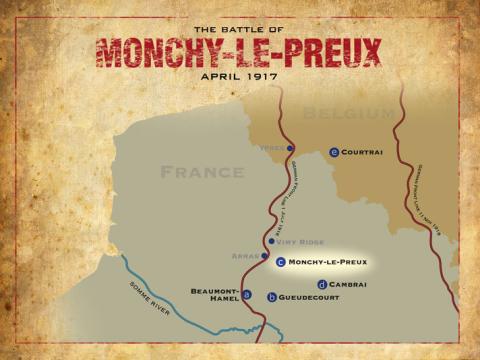
Monchy-le-Preux, France
The Plan
On April 14, 1917, the Newfoundland and Essex Regiments received orders to continue the push east from Monchy-le-Preux. They would advance behind a creeping barrage towards their first objective, Shrapnel Trench. They were then to continue to Infantry Hill, 914 metres outside the village. Once captured, these objectives would further deepen the Allies' salient into German territory.
Initial battle plans had called for the 87th and 88th Brigades to advance simultaneously. However, on April 13, military authorities realized that the 87th Brigade, which had been doing relief work, would not have time to get organized for the attack. They decided that the 88th Brigade would proceed on its own. Further, the battle plan only involved two regiments from the 88th Brigade — the Essex and the Newfoundland.
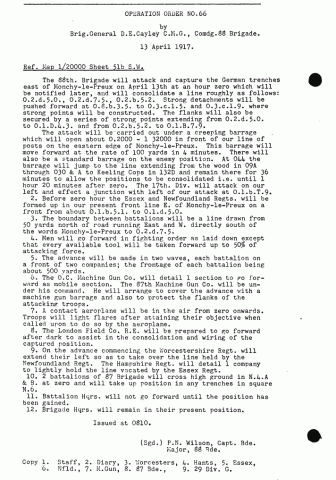
Operation Order 66
13 April 1917
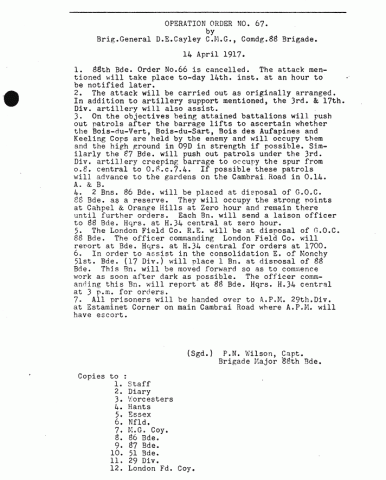
Operation Order 67
14 April 1917
With no support available on the Regiment's right, it was decided that "A" Company would prepare strongholds to the right of the advancing "C" and "D" Companies. These strongholds would be the Regiment's only protection on its right flank (side) as it advanced into enemy territory.
The Action
At 0530 on April 14, the Newfoundland Regiment began its advance behind a creeping barrage. Although some men were lost to enemy machine-gun fire, the Regiment soon reached its first objective — Shrapnel Trench. Troops found this deserted and proceeded to Infantry Hill. By 0730, with both of their objectives taken, the Newfoundland and Essex Regiments began to secure their positions.
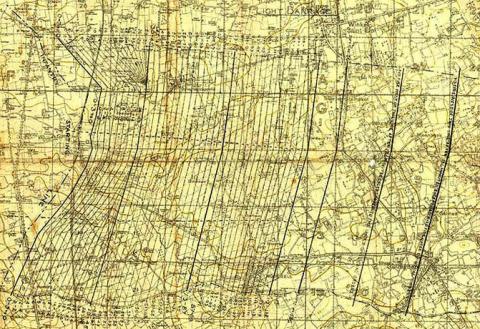
Creeping Barrage Map
Each line on the map represents the next movement of the troops. The troops were expected to move approximately 100 metres every two minutes.
At about 0800, the Germans began a strong counterattack. It soon became apparent that the Germans had used an elastic defence. With the Essex and Newfoundland Regiments in a salient, the Germans were able to attack them on three sides. Soon the Germans were able to move in behind the two Regiments and "pinch" them off from the village of Monchy-le-Preux. After fierce fighting, most of the Essex and Newfoundland men were either captured or killed.
Back at Battalion Headquarters in Monchy-le-Preux, commanders were having trouble determining what was happening on the battlefield. To help clarify the situation, the Newfoundland Regiment's Colonel Forbes-Robertson sent a soldier to investigate. The soldier soon returned with news — it appeared that all of the Regiment's men were either wounded or dead and that 200 to 300 Germans were advancing on the village.
Diary Excerpt: Anthony James Stacey (#466)
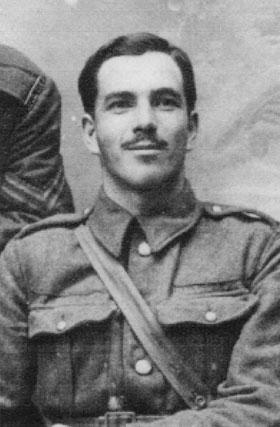
Anthony James Stacey Regt.#466
Image courtesy of Stacey family
I had just settled down when the attack started. Shells began to fly. A basement was our headquarters with about twenty steps leading up to the yard and there were small long windows at ground level which gave light. These windows soon became blocked with falling brick caused by German shells. Time went on. There was no word from the outside as Monchy was receiving a furious bombardment. At 9:00 a.m. there was still no word as to how the attack was progressing. Our CO, Forbes-Robertson, told me to go out to see if there was anything I could see or find out. I went out on the main road and saw an Essex sergeant passing. He was wounded in the leg and on his way back. I asked him to come and see our CO. He refused at first but then he followed me into headquarters. The CO asked him about the advance. He said that the two regiments, Newfoundland and Essex, were surrounded. Captain Keegan went out to investigate and his report was not very pleasant. Forbes said "Stand to". Up the stairs he went, grabbing a rifle and bandolier from a dead man. The rest followed him.
Thus began the second story of the Newfoundland Regiment at Monchy-le-Preux. Colonel Forbes-Robertson immediately gathered every available man, approximately twenty, to head off the German attack. Scavenging weapons and ammunition from dead and wounded soldiers, this small group of men braved enemy fire in an attempt to reach a well-banked hedge at the edge of town. Only nine of the men actually made it, and they were later joined by one soldier from the Essex Regiment.
The men reached the edge of the village at 1050 and immediately began firing on the advancing enemy. Their shooting was so rapid and accurate that it successfully repelled the German attack — shooting down waves of advancing German soldiers in the open field. Additionally, the soldiers targeted German scouts in an effort to keep the enemy ignorant of the size of the force opposing them. The British Official History of the battle records that for the next four hours, those ten men "represented all that stood between the Germans and Monchy, one of the most vital positions on the whole battlefield."
The Heroes of Monchy
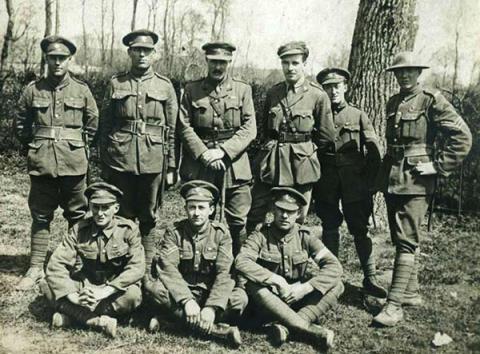
Back (l-r) Cpl. A.S. Rose, Sgt. W. Pitcher, Lt.-Col. J. Forbes-Robertson, Lieut. K.J. Keegan, Sgt. C. Parsons, Sgt. J. R. Waterfield.
Front (l-r) Pte. F. Curran, Cpl. J.H. Hillier, Pte. J. Hounsell
The Rooms Provincial Archives VA 36-38.1
By 1400, enemy fire subsided. Colonel Forbes-Robertson sent one of the men back to seek reinforcements, which they received at 1445. Together they continued to hold off the enemy until they were finally relieved at 2000.
The Outcome
Although a small band of Newfoundland Regiment soldiers had managed to save the village of Monchy-le-Preux on April 14, the rest of the Newfoundland and Essex Regiments had been decimated. Between the two Regiments, approximately 1000 of the 1300 men who advanced on Infantry Hill were killed, wounded, or taken prisoner. From the Newfoundland Regiment, 166 men were killed, 141 were wounded, and 150 were taken prisoner. In fact, more Newfoundlanders and Labradorians were lost in the fighting at Monchy-le-Preux than in any other engagement except Beaumont-Hamel.

Monchy-le-Preux Fatalities
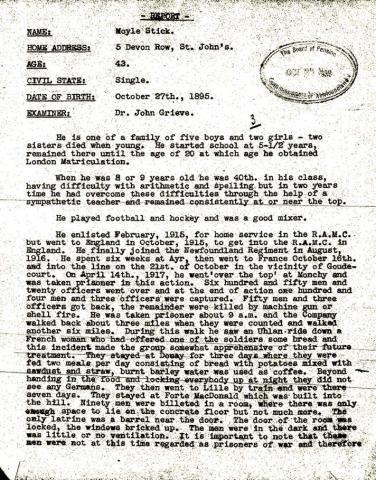
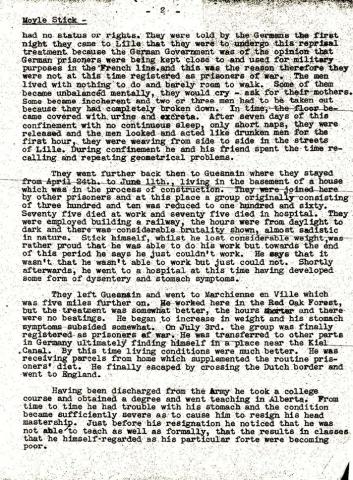
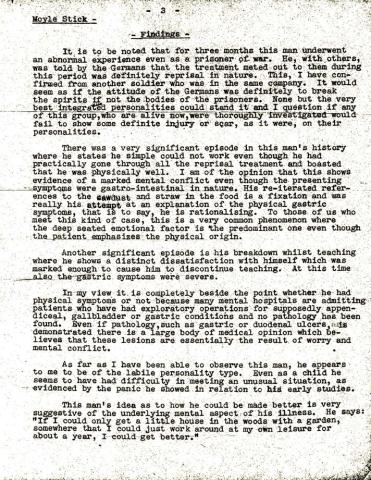
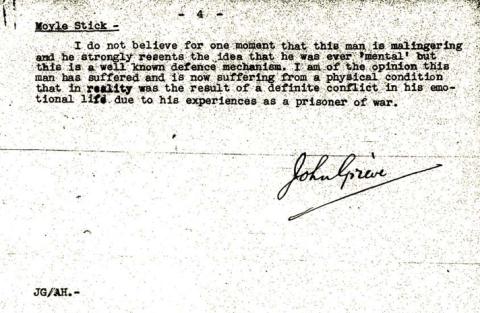
Regimental File #2245
The Rooms Provincial Archives
On April 23, the surviving members of the Newfoundland Regiment played another role in the Arras campaign. They served a supportive role in the Second Battle of the Scarpe. Another sixty-three men were lost in this engagement. The Battle of Arras finally came to a close on May 16, 1917. Although British troops made some territorial advances, 160 000 men died in the campaign.
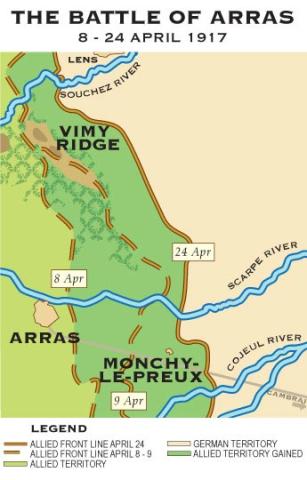
Territory Gained